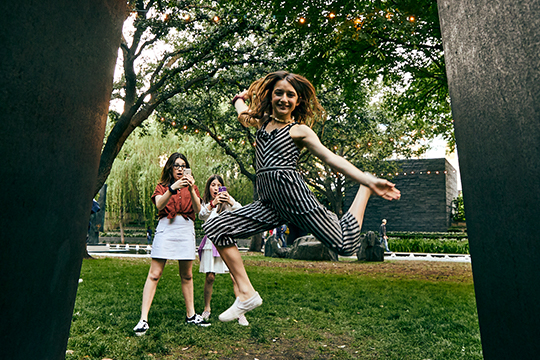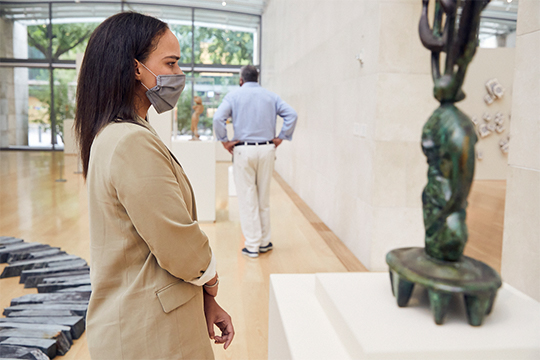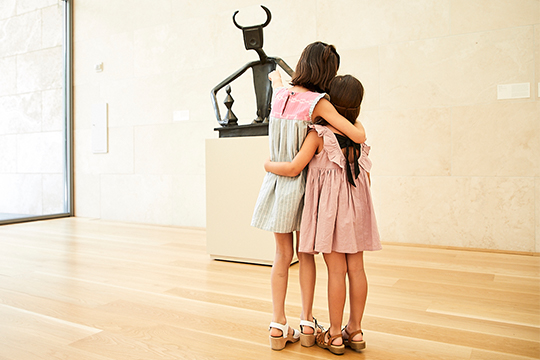The Latin phrase, meaning “And in Arcadia [am] I,” implies that even in Arcadia—an idyllic, bountiful land of ancient legend—death is still present. The works in this installation consider other aspects of Mediterranean culture and its heritage beyond the more familiar values of classicism.
About Track 8: Et in Arcadia Ego
When Italian architect Renzo Piano designed the Nasher Sculpture Center, his central frame of reference was the classical architecture of the Mediterranean, its values of order, restraint, and balance, and the human scale of its design. References to this ancient architectural tradition abound in the building’s symmetrical galleries, the rational clarity of its proportions, and its travertine-clad walls. The glass roof and wall of windows at either end of the building, providing abundant natural light, were inspired by the ruins of ancient Greek and Roman temples, lacking roofs and thus open to the elements, at archaeological sites around the Mediterranean. Piano’s concept for the Nasher was rooted in his own culture; as an Italian, he was accustomed to the appearance of centuries-old buildings in the midst of a bustling urban center. Such juxtapositions have also stimulated the imaginations of artists, who for centuries have sought out the Mediterranean not only to study its classical heritage but also to experience its dense concentrations of diverse cultures and histories.
“Et in Arcadia Ego” is the title of a 17th-century painting by the French artist Nicolas Poussin. The Latin phrase, roughly meaning “And in Arcadia [am] I,” which appears on a tomb discovered by a small group of shepherds, implies that even in Arcadia—an idyllic, bountiful land of ancient legend—death is still present. The works in this installation consider other aspects of Mediterranean culture and its heritage beyond the more familiar values of classicism. This “other” Mediterranean considers death, violence, and the need to mourn, as in the case of works by Elliott Hundley, Alberto Giacometti, and Cy Twombly. But it also encompasses vital, unpredictable energies, creating space for a wide spectrum of passions and desires.
Audio Guides
Hear different perspectives on works in Track 8: Et in Arcadia Ego.
Remix
Discover more about sculpture. Find bonus content like video tours, inspiration playlists, and insights from curators, educators, and living artists.

Best of Et in Arcadia Ego
Bringing together the greatest hits of Track 8: Et in Arcadia Ego artists and themes.
Article: Nicole Eisenman's Fountain
Video: Natural Light at the Nasher
Video: Architect Renzo Piano

Deep Dive
Top recommendations to dig deeper into your favorite artworks and art trends.
Video: David Bates on Sculpture with the Freshness of Drawing
Video: A Legacy in Clay: The Ceramics of Pablo Picasso
Video: Personalities of Sculpture: Nicole Eisenman

Educator Picks
Suggested resources for families, educators, and the young at heart.
Teacher Resource: Lost Wax Casting Process
Video: Create a Petite Picasso
Activity: Continuous-line Blind Contour Drawings with Artist Suzuko Davis
Get Inspired

Listen to a music playlist inspired by artworks in Track 8: Et in Arcadia Ego.
Listen on Spotify.
Explore the Collection
- David Bates, Man with a Snake I, 2000
- Nicole Eisenman, Statue, 2017
- Alberto Giacometti, Head-Skull (Tête-crâne), 1934
- Elliott Hundley, Alas!, 2011
- Aristide Maillol, Night (La Nuit), c. 1902-1909 (cast 1960)
- Aristide Maillol, Seated Nude, Holding her Right Breast (Study for Harmony), 1940
- Pablo Picasso, Seated Faun (Faune assis, also called Chevre-pied assis), 1951
- Cy Twombly, Untitled, 1987-2004 (cast 2005)